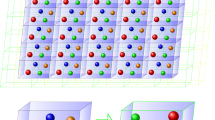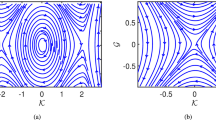Abstract
Local excitations in molecular systems are studied taking into account the influence of soft impurities. The dynamics of activation processes (high-energy events) due to nonlinear mechanisms is studied. The following examples of classical macroscopic systems with strong nonlinear interaction are investigated: 1D Toda chains, 1D Morse rings, and 3D systems of hard spheres including impurities. It is shown that solitonlike excitations may lead to the concentration of energy at definite sites (weak springs or soft spheres). The accumulation of energy is mainly due to soliton-fusion effects. In thermal equilibrium an optimum temperature exists, where the thermally averaged potential energy is preferably partitioned to the soft springs embedded into a hard-spring solvent. Further, we show that the effect of thermal energy localization and the temperature dependence also persists for solutions of soft spheres in hard-sphere solvents.
Similar content being viewed by others
References
P. Hänggi, P. Talkner, and M. Borkovec,Rev. Mod. Phys. 62:251 (1990).
W. Ebeling and M. Jenssen,Ber. Bunsenges. Phys. Chem. 95:1356 (1991).
P. Hänggi, F. Marchesoni, and P. Sudano,Phys. Rev. Lett. 60:2563 (1988); F. Marchesoni,Ber. Bunsenges. Phys. Chem. 95:1350 (1991);J. Chem. Phys. 95:3738 (1991).
A. S. Davydov,Solitons in Molecular Systems (Reidel, Dordrecht, 1985).
A. C. Scott, inEnergy Transfer Dynamics, T. W. Barrett and H. A. Pohl, eds. (Springer, Berlin, 1987); A. C. Scott,Phys. Rev. A 31:3518 (1985).
S. W. Englanderet al., Proc. Natl. Acad. Sci. USA 77:7222 (1980).
M. Frank-Kamenetskii,Nature 328:108 (1987).
V. Muto, A. C. Scott, and P. L. Christiansen,Phys. Lett. A 136:33 (1989).
W. Ebeling and M. Jenssen, inThe Dynamics of Systems with Chemical Reactions, J. Popielawski, ed. (World Scientific, Singapore, 1989).
W. Ebeling, M. Jenssen, and Yu. M. Romanovskii, inIrreversible Processes and Self-Organization, W. Ebeling and H. Ulbricht, eds. (Teubner, Leipzig, 1989).
M. Peyrard and A. R. Bishop,Phys. Rev. Lett. 62:2755 (1989).
A. Fernandez,J. Phys. A 23:247 (1990).
M. Toda,Theory of Nonlinear Lattices (Springer, Berlin, 1981).
C. Camacho and F. Lund,Physica D 26:379 (1987).
W. Ebeling and M. Jenssen,Physica D 32:183 (1988).
M. Jenssen,Phys. Lett. A 159:6 (1991).
J. J. Birktoft and D. M. Blow,J. Mol. Biol. 68:187 (1972).
Yu. M. Romanovskii, A. Yu. Chikishev, and Yu. I. Khurgin,J. Mol. Cat. 47:235 (1988).
W. Ebeling and M. Jenssen,Physica A 188:350 (1992).
Author information
Authors and Affiliations
Rights and permissions
About this article
Cite this article
Ebeling, W., Jenssen, M. Activation by nonlinear oscillations and solitonic excitations. J Stat Phys 70, 49–60 (1993). https://doi.org/10.1007/BF01053953
Issue Date:
DOI: https://doi.org/10.1007/BF01053953




